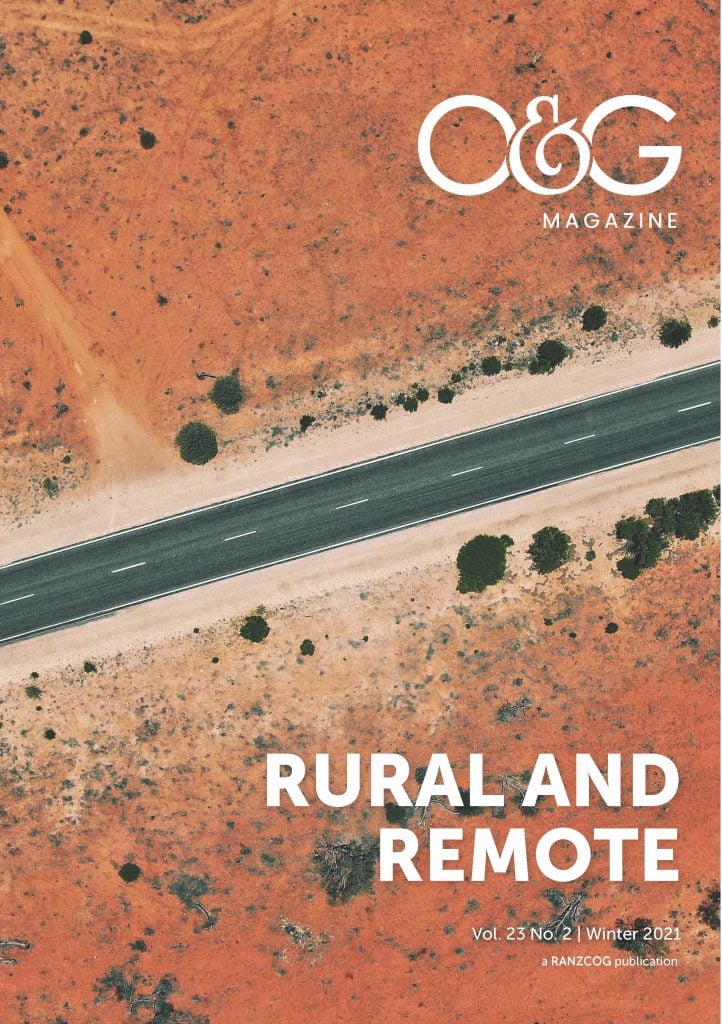From a new Regional Fellow
As a new Fellow, many of us feel daunted by the prospect of being a generalist. With the medicalisation of gynaecology, the further subspecialisation of our craft, and the changed conditions we train under, it can be difficult to feel confident in providing every aspect of women’s healthcare that a regional community needs. Even more intimidating can be leaving the safe confines of the familiar environment in which we trained.
However, what I found as a new Fellow in a regional centre is that you are working amongst colleagues that have a vested interest in mentoring and supporting you. These experienced and wise O&G specialists want and need you to be the best you can be, so that one day you will be able to carry on caring for their community.
So, what did my first year as a consultant look like?
As a consultant, I taught trainees gynaecological surgery, including everything from total laparoscopic hysterectomy to pelvic floor repairs and laparotomies. I supervised breech births and emergency classical caesareans, trained future general practitioner obstetricians (GPOs), taught medical students, resident medical officers, and supported midwifery educators to deliver Practical Obstetric Multi Professional Training. I had to learn quickly how to help plan retrievals with CareFlight from across the vast ‘top end.’ I even participated in a delicate, logistical, web of time-sensitive couriers and flights, to enable an ovarian harvest to be performed for the first time in our region, without the woman having to travel away from family and delay her medical treatment.
I travel a ten-minute commute to work most days but also might travel 873 km to do my outreach gynae clinic as far away as Lajamanu, a small town of the Northern Territory. We carry everything we need, including the colposcope and ultrasound, all on our little chartered plane. Our outreach service is an important piece of the puzzle of health equity, and it is a privilege to participate in it. I have learnt so much about what it means to provide woman-centered care, from our midwives who run the service to the women I get to ‘yarn’ with when I am in the community.
I have had the opportunity to work in Aboriginal community controlled clinics, finally getting to experience healthcare outside of the hospital setting. I have even spent a short stint trying my best to cover GPO services in Nhulunbuy and Katherine, which is by far the best way to understand the very unique, wide-ranging and highly developed skillset GPOs have that sets them apart from the O&G specialist.
I could never have dreamt of all that I would encounter and experience in my first year of being an O&G consultant, or how vastly interesting and rewarding being a Regional Fellow would be. I can only imagine what the rest of my career will bring.
So, should you start your career as a Regional Fellow? Absolutely.
The lifetime experience of a ‘veteran’ Regional Fellow
I write this as a Regional Fellow, who was originally a ‘Provincial Fellow’. The definition of a Provincial Fellow was; ‘A Fellow in an area more than 100 km from a tertiary centre and where there were less than ten specialists locally’.
A Regional Fellow is now defined using the Modified Monash Model. This Australian Government Department of Health workforce classification system defines whether a location is city, rural, remote or very remote. Its data is collected by the Australian Bureau of Statistics.
Most of what I will say also applies to GPOs in regional and rural areas.
It was 1969 when I first became aware of the inequality and inequity of women’s health in rural and remote areas. I had just finished my PGY1 year with a rotation to a regional hospital, when I became aware of the inappropriate management of trophoblastic disease, having spent some time dealing with the disease at the Royal Women’s Hospital as a student. I was then approached by a rural GP, some 400 km from Melbourne, to do a locum for him in January 1970. This also led me to becoming more acutely aware of how difficult it was to maintain good maternity services in rural areas.
Having obtained my specialist qualification, the FRACOG as it was then, I decided to move to a regional area to continue my practice. There were many reasons why I decided to ‘go regional.’
Demographics
The majority of Australians live in the coastal regions Australia, with a few exceptions such as Canberra, Toowoomba, Bendigo and Ballarat, which are all large inland towns. Approximately 30% of Australians live outside major cities; these are the people that regional, rural and remote medical practitioners serve. With a countrywide population of just over 26 million, more than 11.6 million Australians do not have local access to tertiary level obstetric services.
Equality and equity
When I started my career, I worked in a region that had GP services which were also supported by physicians, surgeons and anaesthetic services. Some of the GPs also had interests in paediatrics and obstetrics. The larger district hospital supported several smaller maternity units in the surrounding area. I was able to provide the area with a specialist O&G service, which helped many local women avoid the need to travel to a capital city for ongoing management.
This was in the time before subspecialities, and so my practice covered a full range of obstetrics and gynaecology. I worked with the surgeons in treating oncology cases and with physicians for women with medical conditions in pregnancy. I also developed skills in ultrasound and infertility.
Today, most regional hospitals can provide facilities for a whole range of obstetric and gynaecology procedures, but there is still the need to transfer women for oncology, urogynaecology, tertiary level ultrasounds and maternal-fetal medical problems. Many of these women can still be cared for in a shared care arrangement. Many regional centres are also developing assisted reproductive technology capabilities. Again, the need for travel is reducing.
Lifestyle
Living in a regional area has many benefits. Most regional cities have great schools, including public and private. This means it is easy to get involved with the school community at all levels. When children are involved in activities such as sport, drama or music, being in a regional area, doctor parents can often still attend these activities without being too far away from the practice and/or hospital.
Most regional areas are blessed with cultural resources including performing art centres, art galleries and local entertainment. Many also have renowned visiting performing arts events, such as Bell Shakespeare and Opera Australia, who have both visited my town this year.
Regional areas also have many high-level sporting activities and even offer sports that are difficult to participate in in urban areas such as equestrian, fishing and shooting. Local sporting competitions are often a resource for state-level teams including the AFL, netball, soccer and rugby. It is easy to become involved in all aspects of sport from playing to coaching and administration.
Most regional centres have plenty of outstanding places to eat, usually using local produce that is of a very high quality. There is also a wide variety of food options, thanks to diverse multicultural communities. Many regional restaurants feature in good food guides and regional areas host specific food and wine festivals. For those who like to cook at home, local farmers markets are a great source of high-quality, home-grown produce.
There is always minimal traffic and usually it is very easy to get to work, except for the odd chance of hitting the local ‘traffic jam’ at school pick-up and drop-off times.
Housing and the cost of living are much cheaper than living in the big cities. There is also the option to become a producer and grow your own food, in your garden, farm or even open up a pub!
Workplace
Regional hospitals vary in size and bed numbers, and many regional centres have both public and private hospitals with varying degrees of capability. In hospitals that are more remote, medical staff numbers are usually low and there is some freedom from the medical politics and competition that often occurs in major hospitals in larger cities.
Relationships between nursing, midwifery and medical staff is usually very positive and respectful, as there is an understanding of the need for close collaboration in providing care for rural and remote women. Relations between specialists, GPOs and other health-care providers is also important and again more likely to be very positive compared to larger centres and services.
Whilst working and living in regional areas, there are many opportunities to offer outreach services to even more isolated areas. This allows you to further use and extend your skills in providing services to these remote women. Many regional areas also have large populations of Indigenous women, with regional O&G doctors able to become involved in providing culturally appropriate services.
There can still be some bureaucratic problems that emanate from health departments although relationships with hospital administrations do tend to be more amicable and more personal than in the larger cities. Working in regional areas does involve risk management as well as being able to arrange transfers to larger centres when needed. Ongoing collaboration and communication with other specialists such as anaesthetists and paediatricians is also very important.
Teaching
Most regional hospitals are involved in teaching at all levels, from university students through to advanced FRANZCOG trainees. Teaching students is an important way in which we can assist in recruiting doctors to rural and regional areas and hence the current proliferation of rural clinical schools.
It can be a symbiotic relationship with students asking questions and reminding you to brush up before giving a tutorial or lecture; RANZCOG trainees may even be able to teach you about the latest developments and techniques. There is also the ability to get involved in nursing, midwifery and community education programs.
Practice profile
One of the advantages of regional/rural practice is that you can become more involved with your patients as many become friends or acquaintances and you often see them socially. It is also possible to look after them ‘from womb to tomb’. Understandably, it can be more difficult to deal with any adverse outcomes because of the closeness within the community.
The range of services depends very much on what you would want to do within your skill set and the hospital capabilities. It is often possible to arrange for assistance from a colleague or a GP. Many regional cites will have an older or ‘veteran’ Fellow who is more than willing to assist and mentor you.
Conclusion
Life in a regional city has many advantages and the odd disadvantage. As I said at the start, though I have written this from the perspective of a specialist, I have a great deal of admiration for GPOs who have the benefit of being able to look after the whole family and who provide an essential service to women in regional, rural and remote areas. I also have a great deal of respect for the hospital and community midwives and other health-care workers who make it possible for us to all work in a team to care for the rural and remote women of Australia, providing a safe service close to their home and support network.






Leave a Reply